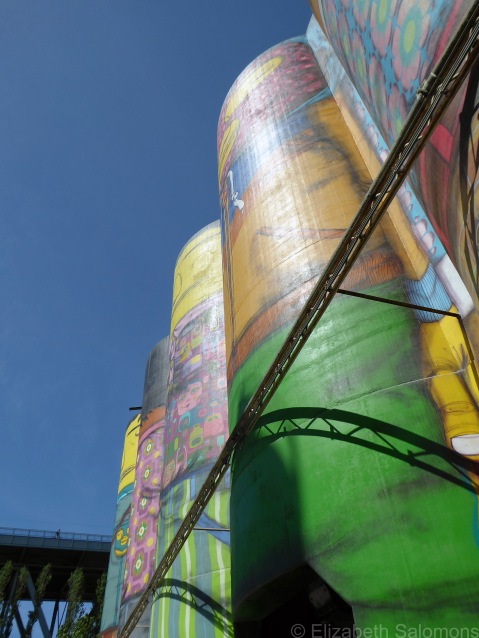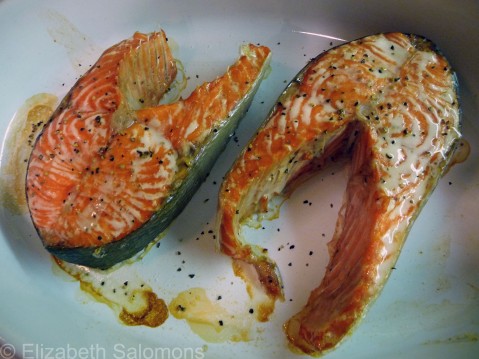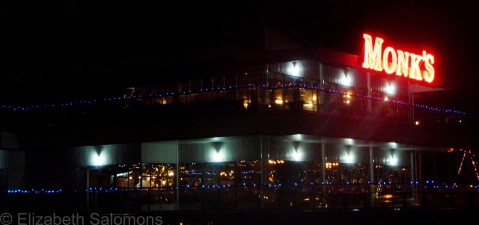Through My Lens: Golden Hour on Beach Avenue

Golden hour. Magic hour.
No matter what you call it, end-of-day light is enchanting.
Through My Lens: Autumn Ride

I like to think of this photo as a companion piece to a photo I took a year ago in almost the exact same spot. This is along the north side of False Creek.
Love these colours.
Through My Lens: Autumn Walk

After all my whinging about the rain, we’ve had some spectacular fall days these past couple of weeks.
And here’s a thing about Vancouver: when it stops raining, the entire city drops what they’re doing and goes for a walk.
Because, this time of year, we know it won’t last.
Vancouver Biennale: Giants
Every city needs art and art has to be in the middle of the people.” — OSGEMEOS

The Vancouver Biennale is a two-year-long outdoor public art installation that takes place every two or three years. The first was from 2005 to 2007, the second from 2009 to 2011, and the latest, the third Biennale, began in the spring of 2014 and finishes up this year.

The installations by world-renown artists are scattered across Greater Vancouver. The most impressive piece of this latest Biennale is Giants by the twin Brazilian brothers, Gustavo and Otávio Pandolfo, who call themselves OSGEMEOS. (Os gemeos is Portuguese for “the twins.”)

Giants consists of murals painted on six concrete silos located at Ocean Concrete on Granville Island. (An aside: this concrete factory is the last vestige of False Creek’s industrial past.) The murals alternate between facing the water and facing inland. They are colourful, and they are cheerful, which seems to be a hallmark of the most successful installations of the Biennale. None are intended to be permanent, but sometimes we just can’t bear to let them go. Hopefully this one will be kept on as well.

Oh, and any guesses as to how much paint was used?
A mere 1400 cans.
Expo Lands

When Expo 86 closed its gates 30 years ago today, it finished as a far more successful world’s fair than it ever expected to be. Sure, Vancouver had high hopes for the fair and saw it as a great way to celebrate its 100th birthday, as well as the 100th anniversary of the completion of the Canadian Pacific Railway that brought British Columbia into Confederation. A total of 38 countries participated, but it was getting the United States, the Soviet Union, China, and Cuba to all participate that was the real coup. And the number of visitors was far greater than predicted. Most British Columbians credit Expo with bringing the province out of one of its worst recessions.

On October 14, 1986, the question on everyone’s mind was: what happens to the fairgrounds? Prior to Expo 86, the 90-hectare site was an industrial wasteland. Sawmills and railway lands had been expropriated to make room for the fairgrounds (it boggles my mind that Vancouver had working sawmills in its downtown core in my lifetime), but with rezoning came all sorts of possibilities.
In the end, what came to be known as the Expo lands was sold to a single Chinese developer. The price was controversial, but in return for a good deal on the land, the developer agreed to build child-care centres, playgrounds, a community centre, and a school. Furthermore, the condos had to include a certain percentage of family-size units and affordable housing.

The result? A slow and careful development of a entirely new inner-city neighbourhood that, once populated, doubled the number of people living in Vancouver’s downtown core. It’s not completely finished; the last section still remains a parking lot while awaiting the demolishment of the Georgia and Dunsmuir Viaducts ― the remnants of the freeway into downtown Vancouver that never saw completion.
Vancouver is consistently rated as one of the most livable cities in the world and the development of the Expo lands has a lot to do with that rating. Today, the area is covered in condo towers. Agreed, they are not the most creative architecturally. But you only have to take a walk through the neighbourhood and marvel that, only 30 years ago, there was nothing there but a wide swath of empty land.

SkyTrain

Some say the most significant legacy of Expo 86 is our SkyTrain. It certainly is a fitting legacy for a world’s fair whose full name was World Exposition on Transportation and Communication.
During Expo, the SkyTrain took fairgoers from the Canada Pavilion at Canada Place to the main fairgrounds beside where Science World is located today.
The SkyTrain ― which now runs all the way to Surrey ― is a narrow elevated train. Too narrow, in my mind, as it’s too much of a crush at rush hour. And it’s so narrow that, when you compare it to subway trains like those in Toronto or New York, it feels like you’re riding a toy train.
The SkyTrain is all modern, though. It was the world’s first completely automated (read: driverless) rapid transit system. Daily ridership is around 400,000 passengers.
Science World

Another legacy site of Expo 86 is Science World. During Expo, it was called Expo Centre. Like most of the pavilions, it was intended to be dismantled at the end of the fair, but intense public opposition to that plan saved it, and it was turned into a science and technology centre instead.
During the 2010 Winter Olympics, it was transformed into Sochi World ― locally referred to as the Russia House ― to promote the 2014 Winter Olympics and to function as the hospitality area for the Russian national team.

Through My Lens: Foggy Bridges

Fog is a fact of life in Vancouver during the winter months. It can roll in from the ocean within a manner of minutes and stick around for weeks at a time. If the wind is in the right direction, I hear the fog horns from the freighter ships moored in English Bay, which is kinda cool. (What’s really cool is how they play those horns in harmony.)
The fog showed up again last night and was still here this morning, but I took this photo of the bridges over False Creek a few years ago.
Recipe Box: Sockeye Salmon
A sure sign that summer is morphing into fall is when the salmon start running.
Four years ago, the Fraser River had the salmon run of the century. More than 30 million sockeye swam up river to spawn that year ― the highest number since 1913. This year, their offspring are returning to spawn in spades, and both the commercial and sports fisheries are expected to match their harvest of 2010. (Time for a quick biology lesson ― just in case it’s needed. Salmon are born in freshwater rivers, migrate to the ocean, then return to the rivers to spawn. They always return to the river where they were born; thus, it can be predicted that a good salmon run one year will result in another good run several years later.)

Now, if you live along the West Coast (as I do), you have the good fortune to be able to buy sockeye right off the boat (as they say). I bought a nice four-pounder last weekend. (I asked for the smallest one they had ― most were much bigger.) This year the sockeye are so prolific that the fishmonger up the street is matching the price I paid at the dock, and even my local big-chain grocery store is stocking whole salmon.

What to do with a whole salmon, you ask? Why, you fillet it. Or you cut it into steaks. (Trust me: YouTube is your friend on days like these.)
And then you grill it, bake it, pan fry it … the options are myriad.
I’ve tried all kinds of recipes, but my favourite way to prepare sockeye salmon is to keep it simple: season with salt and pepper, then pop it into a preheated 450°F oven. Bake for about 12 minutes, no longer. The key when cooking salmon in the oven is to not overbake it or it will be too dry.
And then: enjoy!

Dishing: Monk McQueens

Last night was one night I regretted showing up late to the party. Monk McQueens at Stamps Landing on the south side of False Creek has been a Vancouver landmark ever since it opened during Expo 86. And yet, I’d never been. The announcement that it was shutting its doors for the last time on December 31 of this year was what finally motivated me to experience this famous fresh seafood and oyster bar for myself.
I made an occasion of it by reserving a table for the same night a friend from Boston was going to be in town. And so, five of us gathered last night to enjoy a leisurely dinner and a bit of a catch-up. Our table in one of the corner windows gave us a terrific view of False Creek.

The food was delicious. My Bostonian friend and I shared a half dozen oysters on the half shell. For our mains, our party of five sampled almost every type of seafood on the menu: halibut, sea bass, sablefish, lobster, and scallops. We washed it all down with a very nice bottle of wine, and finished with coffee, brown sugar vanilla bean cheesecake, and Calvados. I can’t think of a nicer way to spend four hours with good friends on one of the last nights of the year.
Mahony & Sons Public House is moving in after Monk’s vacates the premises and will open sometime next summer. As much as I enjoy a good public house, it won’t be the same. Last night was proof that just because an establishment has been around since the Dark Ages (aka the 1980s) doesn’t mean it should be taken for granted. Pity I did.
